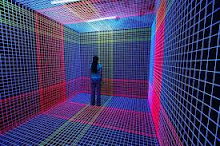Here at Art View the hope is to bring you the future this is to loop invisible prototype with metal rubber composite and make a kind of android two types one is made of light in 3D the other is a solid matter looping a horizon program project to allow for better taught process this uses the calculation of regulating data tracks of time. None the less these new prototype drawings are all here for you on Art View a breakthrough: This is the 'cloak', which is actually a lump of calcite crystal, can make objects like pins and paper clips disappear from sight it creator Dr Zhang said: 'This is a huge step forward as, for the first time, the cloaking area is rendered at a size that is big enough for the observer to "see" the invisible object with the naked eye. But by using natural crystals for the first time, rather than artificial meta-materials, we have been able to scale up the size of the cloak and can hide larger objects, thousands of times bigger than the wavelength of the light. 'Previous cloaks have succeeded at the micron level (much smaller than the thickness of a human hair) using a nano - or micro-fabricated artificial composite material. 'It is a very slow process to make these structures and they also restrict the size of the cloaking area.

At Art View the believe that by using calcite, we can start to develop a cloak of significant size that will open avenues for future applications of cloaking devices.' The research has been published in the journal Nature Communications in a paper titled Macroscopic Invisibility Cloak of Visible Light. An invisible Chevy Chase in the 1992 film Memoirs Of An Invisible Man. Scientists have now built an 'invisibility cloak' that can hide everyday objects by splitting light Physicists from the University of Birmingham and colleagues from Imperial College, London, and Technical University of Denmark, said using the natural crystal enabled them to hide bigger objects than other researchers this can be used with an androids or E Reader.

This e team, led by Dr Shuang Zhang, from the university's school of physics and astronomy, glued two triangular pieces of calcite together, placed on a mirror. The light enters the calcite and splits into two rays of different polarizations travelling at different speeds and in different directions. Although the cloak itself is visible, it hides objects placed underneath it. The researchers said the size of the cloaking area was not limited by the technology available but the size of the crystal and their experiments might pave the way to more devices which can hide much larger objects. Scientists have previously only been able to cloak microscopic objects, but a new study has taken a giant step forward by making items thousands of times bigger turn invisible.

With this new calculation equal to 206 AU (T) Data 1 time that not yet perfect here is the view of an E reader its the future but here now to buy.
 At Art View the believe that by using calcite, we can start to develop a cloak of significant size that will open avenues for future applications of cloaking devices.' The research has been published in the journal Nature Communications in a paper titled Macroscopic Invisibility Cloak of Visible Light. An invisible Chevy Chase in the 1992 film Memoirs Of An Invisible Man. Scientists have now built an 'invisibility cloak' that can hide everyday objects by splitting light Physicists from the University of Birmingham and colleagues from Imperial College, London, and Technical University of Denmark, said using the natural crystal enabled them to hide bigger objects than other researchers this can be used with an androids or E Reader.
At Art View the believe that by using calcite, we can start to develop a cloak of significant size that will open avenues for future applications of cloaking devices.' The research has been published in the journal Nature Communications in a paper titled Macroscopic Invisibility Cloak of Visible Light. An invisible Chevy Chase in the 1992 film Memoirs Of An Invisible Man. Scientists have now built an 'invisibility cloak' that can hide everyday objects by splitting light Physicists from the University of Birmingham and colleagues from Imperial College, London, and Technical University of Denmark, said using the natural crystal enabled them to hide bigger objects than other researchers this can be used with an androids or E Reader.  This e team, led by Dr Shuang Zhang, from the university's school of physics and astronomy, glued two triangular pieces of calcite together, placed on a mirror. The light enters the calcite and splits into two rays of different polarizations travelling at different speeds and in different directions. Although the cloak itself is visible, it hides objects placed underneath it. The researchers said the size of the cloaking area was not limited by the technology available but the size of the crystal and their experiments might pave the way to more devices which can hide much larger objects. Scientists have previously only been able to cloak microscopic objects, but a new study has taken a giant step forward by making items thousands of times bigger turn invisible.
This e team, led by Dr Shuang Zhang, from the university's school of physics and astronomy, glued two triangular pieces of calcite together, placed on a mirror. The light enters the calcite and splits into two rays of different polarizations travelling at different speeds and in different directions. Although the cloak itself is visible, it hides objects placed underneath it. The researchers said the size of the cloaking area was not limited by the technology available but the size of the crystal and their experiments might pave the way to more devices which can hide much larger objects. Scientists have previously only been able to cloak microscopic objects, but a new study has taken a giant step forward by making items thousands of times bigger turn invisible.  With this new calculation equal to 206 AU (T) Data 1 time that not yet perfect here is the view of an E reader its the future but here now to buy.
With this new calculation equal to 206 AU (T) Data 1 time that not yet perfect here is the view of an E reader its the future but here now to buy.



